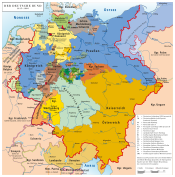Saxe-Coburg-Saalfeld
Duchy of Saxe-Coburg-Saalfeld Herzogtum Sachsen-Coburg-Saalfeld | |||||||||||||
|---|---|---|---|---|---|---|---|---|---|---|---|---|---|
| 1735–1826 | |||||||||||||
Ernest III (last) | |||||||||||||
| Historical era | 11 February 1826 | ||||||||||||
| |||||||||||||
Saxe-Coburg-Saalfeld (
Saxe-Saalfeld 1680 to 1735

After the Duke of
When Albert V, the Duke of Saxe-Coburg, died in 1699 without any surviving descendants, disputes arose over the inheritance, especially with Bernhard I of Saxe-Meiningen, and they were not settled until 1735. Most of the Saxe-Coburg properties were given to the new Ernestine line of Saxe-Saalfeld and the Principality of Saxe-Coburg-Saalfeld was born with John Ernest as its Duke (not Prince). However, the Districts of Sonneberg and Neuhaus am Rennweg had to be handed over to Saxe-Meiningen and the District of Sonnefeld had to be given to Saxe-Hildburghausen. One-third of the District of Römhild and five-twelfths of the District of Themar remained with Saxe-Coburg.
Saxe-Coburg-Saalfeld 1735 to 1826
After the death of John Ernest IV in 1729, his sons

Duke
It was the children of Duke Francis Frederick Anton who assured the dynastic success and survival of the House of Saxe-Coburg. The fame of Prince Frederick Josias led to the wedding of his daughter,
On 15 December 1806, Saxe-Coburg-Saalfeld, along with the other Ernestine duchies, entered the
The extinction of the oldest line, Saxe-Gotha-Altenburg in 1825 again led to inheritance disputes among the other lines of the Ernestine family. On 12 November 1826 the decision, from the arbitration of the supreme head of the family, King Frederick Augustus I of Saxony, resulted in the extensive rearrangement of the Ernestine duchies. Most of Saxe-Hildburghausen and Saalfeld were given to Saxe-Meiningen along with a few various cities.[2] The Duchy of Saxe-Gotha was left without the Districts of Kranichfeld and Römhild, which fell to Saxe-Meiningen, and without the domain of Altenburg (Districts of Altenburg, Ronneburg, Eisenberg, Roda and Kahla), which turned the Duchy of Saxe-Hildburghausen into the Duchy of Saxe-Altenburg. But Saxe-Coburg gained from Saxe-Hildburghausen the two Districts – Königsberg and Sonnefeld.
The new duchy of Saxe-Coburg and Gotha was born as a personal union of the two duchies of Saxe-Coburg and Saxe-Gotha. Ernest III, the last Duke of Saxe-Coburg-Saalfeld, then became Ernest I, the first Duke of Saxe-Coburg and Gotha.
Dukes of Saxe-Coburg-Saalfeld
- 1680–1729 Johann Ernest IV, son of Ernst I, Duke of Saxe-Gotha-Altenburg
- 1729–1745 Christian Ernest II, son of the previous Duke (reigned with his brother Francis Josias with the residence in Saalfeld)
- 1745–1764 Francis Josias, brother of the previous Duke (reigned until 1745, together with his brother Christian Ernest with the residence in Coburg)
- 1764–1800 Ernest Frederick, son of the previous Duke
- 1800–1806 Francis Frederick, son of the previous Duke
- 1806–1826 Ernest III, son of the previous Duke (since 1826, Ernest I, Duke of Saxe-Coburg and Gotha, died 1844)
Prime Ministers of Saxe-Coburg-Saalfeld
- 1801–1808 Theodor Konrad von Kretschmann
- 1808–1822 Johann Ernst Gruner
- 1823–1824 Ludwig Hofmann
- 1824–1840 Christoph Anton Friedrich von Carlowiz (until 21 January 1840)
See also
References
- ISBN 3-00-008525-4, page 32
- ^ G. Long, ed. (1841). The penny cyclopædia. p. 481.
Bibliography
- (in German) Carl-Christian Dressel, Die Entwicklung von Verfassung und Verwaltung in Sachsen-Coburg 1800 - 1826 im Vergleich [The Development and Comparison of the Constitution and Administration of Saxe-Coburg 1880 – 1826] (Berlin: Duncker & Humblot, 2007), ISBN 978-3-428-12003-1.
- (in German) Johann Hübner, Drey hundert drey und dreyßig Genealogische Tabellen: nebst denen darzu gehörigen genealogischen Fragen zur Erläuterung der politischen Historie, mit sonderbahrem Fleiße zusammen getragen, und vom Anfange der Welt biß auff diesen Tag continuiret; Nebst darzu dienlichen Registern [Three Hundred and Thirty Three Genealogical Tables: Together with those Related Questions of Genealogy to Explain the Political History, Compiled with Great Diligence, and Continuing from the Beginning of the World to This Day; Added Herein with Relevant Records] (Leipzig: Johann Friedrich Gleditsch, 1708) Table No. 166




